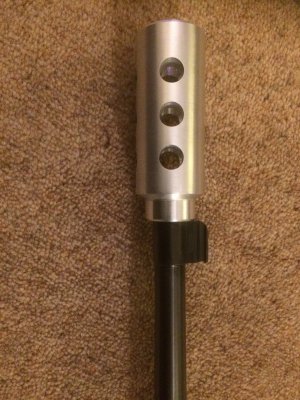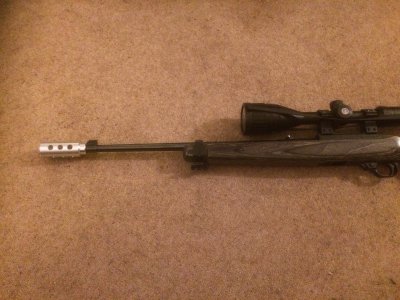I decided I wanted something a little different on the pointy end of the 10/22, rather than a moderator or basic thread protector so I spent an hour on the lathe and knocked out something. A friend of mine says he will do a dye penetration check for any cracks etc, but think it will be ok. Time will tell once I get to the range, might gun black it tho as it will blend in with the barrel better?
-
Welcome back Guest! Did you know you can mentor other members here at H-M? If not, please check out our Relaunch of Hobby Machinist Mentoring Program!
You are using an out of date browser. It may not display this or other websites correctly.
You should upgrade or use an alternative browser.
You should upgrade or use an alternative browser.
Ruger 10/22 Thread Protector/Muzzle Brake
- Thread starter Bertie
- Start date
Looks cool. I don’t think you need to do any sort of dye checking on something with pressures as low as a 22. Heck, I doubt they ever do any sort of testing on compensators, muzzle brakes, flash hiders or suppressors regardless of how high the pressures at the muzzle may be. After all if it breaks to the point of coming off the pieces are most likely to be going the same direction as the piece that intended to be moving.
Sent from my iPhone using Tapatalk
Sent from my iPhone using Tapatalk
- Joined
- Jan 31, 2016
- Messages
- 11,437
After all if it breaks to the point of coming off the pieces are most likely to be going the same direction as the piece that intended to be moving.
I found that out on the .338WM . I didn't want to thread the barrel being it was an older Remington and tried clamping one onto the barrel with a tapered lock ring . It went down range fast , and my shoulder still hurts to this day .

- Joined
- Nov 28, 2016
- Messages
- 2,344
I was at the range one day... there was a guy there with a new .50 Beowulf...
He fired it 4 times, then had to go down range to pick up his muzzle brake... he put it back on (it was 'clamped' with #10-24 set screws), 4 more shots and he had to go pick it up again.
He finally asked me if I could drill and tap it to ¼-20 for the 'extra clamping ability'... I said 'sure, but it won't help much'.
I ended up taking it home and installing ¼-20 setscrews (he insisted that would fix it)...
It helped... he could get 6 shots between trips downrange afterward!
-Bear
He fired it 4 times, then had to go down range to pick up his muzzle brake... he put it back on (it was 'clamped' with #10-24 set screws), 4 more shots and he had to go pick it up again.
He finally asked me if I could drill and tap it to ¼-20 for the 'extra clamping ability'... I said 'sure, but it won't help much'.
I ended up taking it home and installing ¼-20 setscrews (he insisted that would fix it)...
It helped... he could get 6 shots between trips downrange afterward!
-Bear
- Joined
- Oct 11, 2016
- Messages
- 3,857
muzzle breaks can be very complex in their pressure profile. For maximum effect, you need minimal clearance, but too close is also quite destructive. In our testing the forward pressure on the threads amounts to only a few hundred pounds impulse with a .020 bore clearance. That is roughly like putting a hook on it and using a 5 lb slide hammer...
People who want their MB to be held on with set screws don't understand the physics of firearms. It can be done BTW, but it is wrong to think it is the appropriate approach.
People who want their MB to be held on with set screws don't understand the physics of firearms. It can be done BTW, but it is wrong to think it is the appropriate approach.
- Joined
- Dec 16, 2021
- Messages
- 9
Anything clamped to a tapered surface is bound to come off once any movement occurs.
- Joined
- Oct 11, 2016
- Messages
- 3,857
If you have more than .040 learance around the bullet, you have built a sexy barrel accessory, but not a muzzle break; However you lower the risk of having the thing fly off the end of the barrel, which is always good.
NOTE before anyone nit-picks this, these numbers are for a 22LR out of a short barrel like a Ruger 10/22... Using a very high powder cartridge like a 7mm magnum, etc, the clearances and effectiveness of various designs changes completely.
It is not the place to go into the computer simulations for this; for those who are very engineering minded, and have some training, the Danish and Swedish arms companies have posted their analyses online for anyone to see, including FEA models.
NOTE before anyone nit-picks this, these numbers are for a 22LR out of a short barrel like a Ruger 10/22... Using a very high powder cartridge like a 7mm magnum, etc, the clearances and effectiveness of various designs changes completely.
It is not the place to go into the computer simulations for this; for those who are very engineering minded, and have some training, the Danish and Swedish arms companies have posted their analyses online for anyone to see, including FEA models.
- Joined
- Dec 16, 2021
- Messages
- 9
I would not want a brake on a 22lr. The amount of lead dust that would be redirected toward the shooter is not insignificant.



